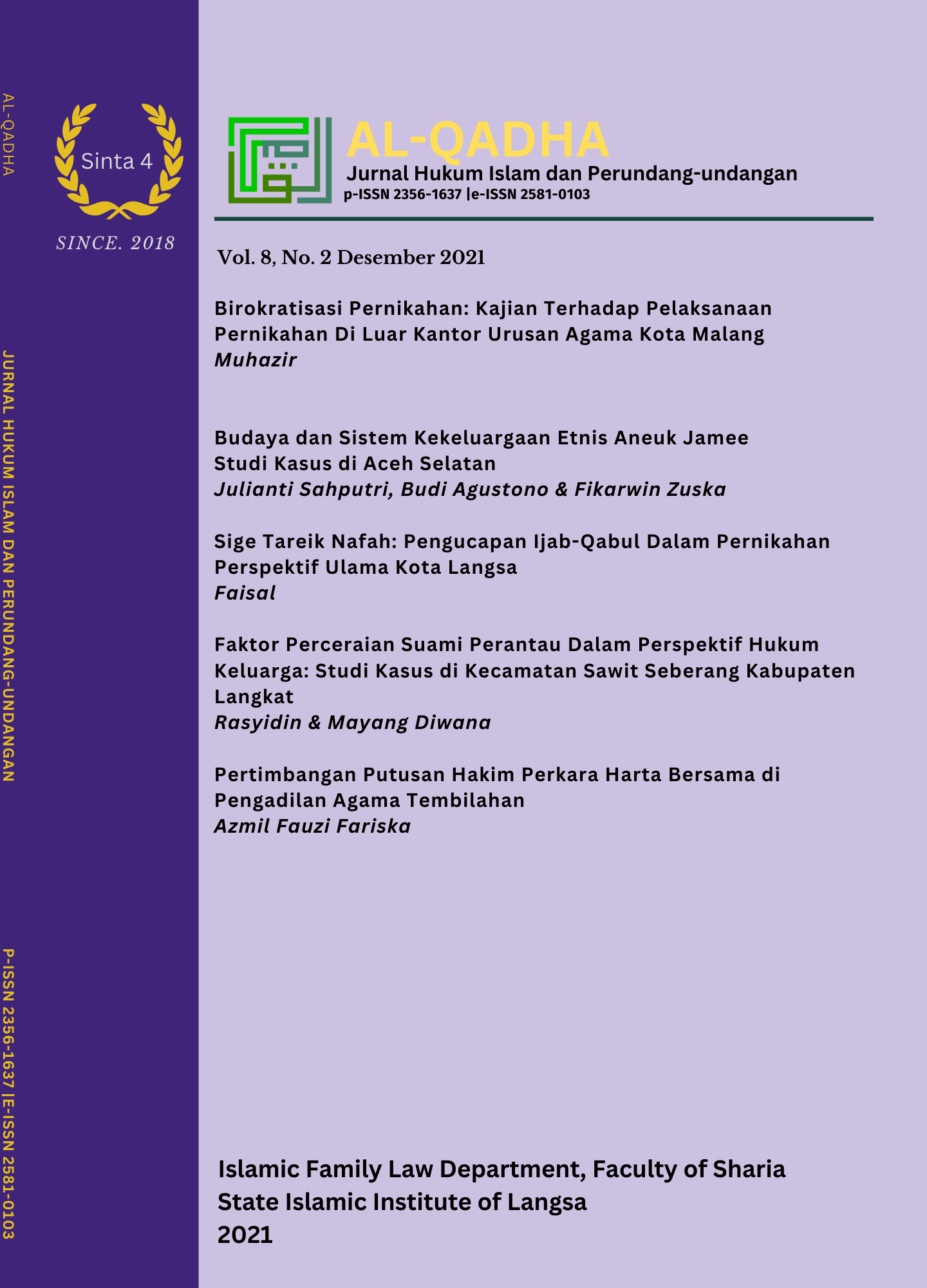Main Article Content
Abstract
The Aneuk Jamee tribe is an acculturation of the Acehnese and Minangkabau tribes, both of which seem to have merged into one individual to produce a new ethnicity. This ethnicity later developed in South Aceh and influenced various aspects of culture and the family system in it. This research is classified as field research with a qualitative approach. The methodology used is phenomenology which is supported by historical literacy in the South Aceh region where the Aneuk Jamee ethnicity is the most dominant. Informants in this study consisted of primary and secondary sources, the primary sources were individuals or native Aneuk Jamee selected by random sampling. The secondary sources are informants who are not native to Aneuk Jamee but have insight and knowledge regarding the history and customs of Aneuk Jamee. The results of the study concluded that the Aneuk Jamee community has similarities with the system in the Minangkabau community in West Sumatra, namely adopting a hereditary system from the mother's side or commonly referred to as Matrilineal. Even though there has been Islamization in Aceh where the father is a descendant of the lineage, the matrilineal system is still evident in kinship (household) matters. All matters that will be carried out in a household must be discussed in advance with the ninik mamak (mother's brother).
Keywords
Article Details
References
- Anwar, Anwar. “Strategi Kolonial Belanda Dalam Menaklukkan Kerajaan Aceh Darussalam.†Jurnal Adabiya 19, no. 1 (July 17, 2020): 13. https://doi.org/10.22373/adabiya.v19i1.7482.
- Anzaikhan, M. “Hakikat Administrasi Pemerintahan Islam.†Al-Ijtima`i: International Journal of Government and Social Science 5, no. 1 (October 30, 2019): 56–80. https://doi.org/10.22373/jai.v5i1.465.
- ———. “Urgensi Filsafat dalam Ilmu Falak dan Relevansinya bagi Kehidupan Beragama Masyarakat.†Substantia: Jurnal Ilmu-Ilmu Ushuluddin 22, no. 2 (October 30, 2020): 107. https://doi.org/10.22373/substantia.v22i2.7664.
- Ariani, Iva. “Nilai Filosofis Budaya Matrilineal Di Minangkabau (Relevansinya Bagi Pengembangan Hak-Hak Perempuan Di Indonesia).†Jurnal Filsafat 25, no. 1 (August 14, 2016): 32. https://doi.org/10.22146/jf.12613.
- Asmon, Rayvaldo Anggriawan, and Zakwan Adri. “Motivasi Merantau Pada Remaja Akhir Minangkabau,†2021, 7.
- Dessy Asnita, Fika Andriana, Agustinar &. “Istri Bergaji: Analisis Peran Wanita Bekerja Dalam Meningkatkan Ekonomi Keluarga.†Al-Qadha : Jurnal Hukum Islam dan Perundang-Undangan 8, no. 1 (July 12, 2021): 13–32. https://doi.org/10.32505/qadha.v8i1.2800.
- Fitriana, Yulita. “Sistem Kekerabatan Matrilineal Dalam Mitos ‘Malin Kundang.’†Jurnal Ilmu Budaya 15, no. 1 (November 4, 2018): 48–67. https://doi.org/10.31849/jib.v15i1.2032.
- Gusti, Erwina, and Siti Aisah Ginting. “The Fading Of Hadih Maja In The Vernacular Language Among Acehnese Teenagers In Banda Aceh,†2016, 5.
- Harun, Mohammad. “Revitalisasi Nilai Etos Kerja Dalam Hadih Maja Sebagai Bahan Ajar Pendidikan Karakter.†Journal of Educational Science and Technology (EST) 1, no. 3 (December 14, 2015). https://doi.org/10.26858/est.v1i3.1824.
- Hermaliza, Essi. “Sistem Kekerabatan Suku Bangsa Kluet Di Aceh Selatan The Kinship System Of Kluet Etnics In South Aceh,†n.d., 10.
- Junaidi, T, and Mufti Riyani. “Ragam Hias Aceh: Corak Identitas Dan Pemaknaannya Dalam Masyarakat Nelayan Dan Peladang,†2017, 20.
- Khalidah, Muhammad Nasir. “Penyelesaian Pembagian Warisan Di Kecamatan Simpang Ulim Dalam Perspektif Hukum Islam dan Hukum Adat.†Al-Qadha : Jurnal Hukum Islam dan Perundang-Undangan 8, no. 1 (July 12, 2021): 33–49. https://doi.org/10.32505/qadha.v8i1.2997.
- Marta, Suci. “Konstruksi Makna Budaya Merantau Di Kalangan Mahasiswa PerantaU.†Jurnal Kajian Komunikasi 2, no. 1 (2014): 17.
- Munir, Misnal. “Sistem Kekerabatan Dalam Kebudayaan Minangkabau: Perspektif Aliran Filsafat Strukturalisme Jean Claude Levi-Strauss.†Jurnal Filsafat 25, no. 1 (August 14, 2016): 1. https://doi.org/10.22146/jf.12612.
- Mursyidin, Mursyidin, Rahmad Nuthihar, Wahdaniah Wahdaniah, and RN Herman. “Understanding Acehnese Proverbs and Their Relation to the Community Work Ethics,†n.d., 6.
- Nazaruddin, M. “Dimensi pembentuk kesadaran identitas keacehan dan citra diri Aceh.†Masyarakat, Kebudayaan dan Politik 27, no. 1 (January 1, 2014): 44. https://doi.org/10.20473/mkp.V27I12014.44-54.
- Paisal, Jon. “Peran Dakwah Dalam Keluarga Dan Relevansinya Bagi Pembentukan Karakter Anak.†Al-Qadha : Jurnal Hukum Islam dan Perundang-Undangan 8, no. 1 (July 14, 2021): 50–66. https://doi.org/10.32505/qadha.v8i1.2726.
- Pohan, Muslim. “Fenomena dan Faktor Perkawinan Semarga.†Al-Qadha : Jurnal Hukum Islam dan Perundang-Undangan 8, no. 1 (July 14, 2021): 67–84. https://doi.org/10.32505/qadha.v8i1.2088.
- Ramanta, Helzi, and Samsuri Samsuri. “The Values of Local Wisdom of Minangkabau Culture in a Baralek Gadang Traditional Wedding.†Humaniora 11, no. 3 (November 30, 2020): 193–201. https://doi.org/10.21512/humaniora.v11i3.6625.
- Rozi, Safwan. “Negosiasi Islam Kultur Dalam Gerakan Paderi Rao Di Sumatera Tengah (1820-1833).†KALAM 6, no. 1 (February 24, 2017): 85. https://doi.org/10.24042/klm.v6i1.396.
- Sidik, Humar. “Christiaan Snouck Hurgronje Dalam Dinamika Islam Di Aceh Pada Masa Kolonial Belanda.†Jurnal Artefak 7, no. 1 (May 1, 2020): 31. https://doi.org/10.25157/ja.v7i1.3282.
- Sovia Firdaus, Dwi Rini, Djuara P.Lubis, Djoko Susanto, and Endriatmo Soetarto. “Portrait of The Minangkabau Culture According to Hofstede’s Six Cultural Dimensions.†Sodality: Jurnal Sosiologi Pedesaan 6, no. 2 (September 13, 2018). https://doi.org/10.22500/sodality.v6i2.23229.
- Zulfikar, Zulfikar, Adi Isworo Josef, and Ratna Endah Santoso. “Penerapan Teknik Kasab Aceh Pada Produk Sepatu Wanita Dewasa.†CORAK 8, no. 2 (August 3, 2019): 113–22. https://doi.org/10.24821/corak.v8i2.2793.
